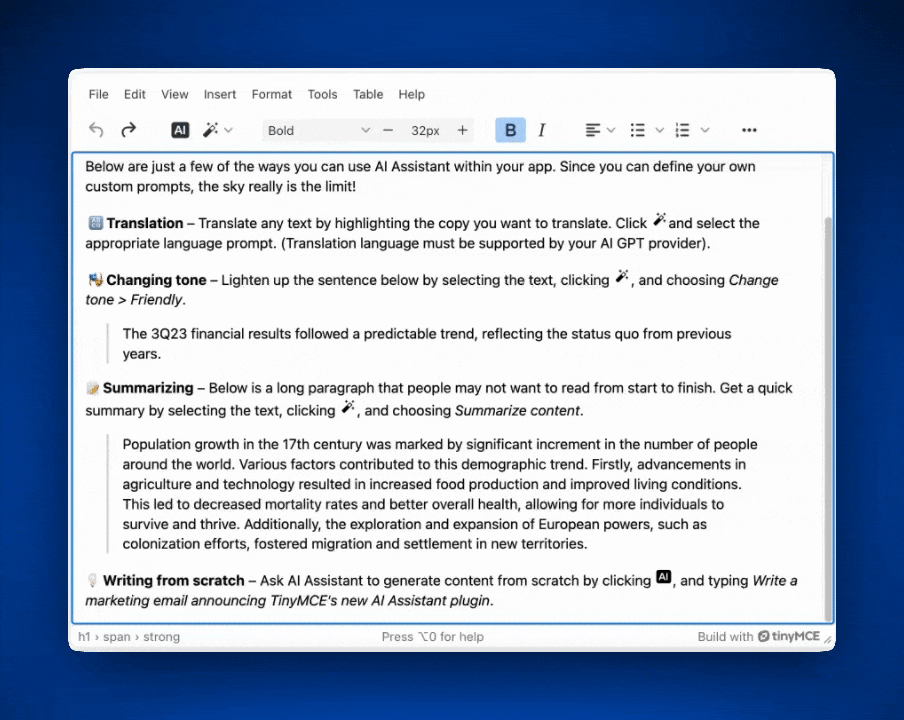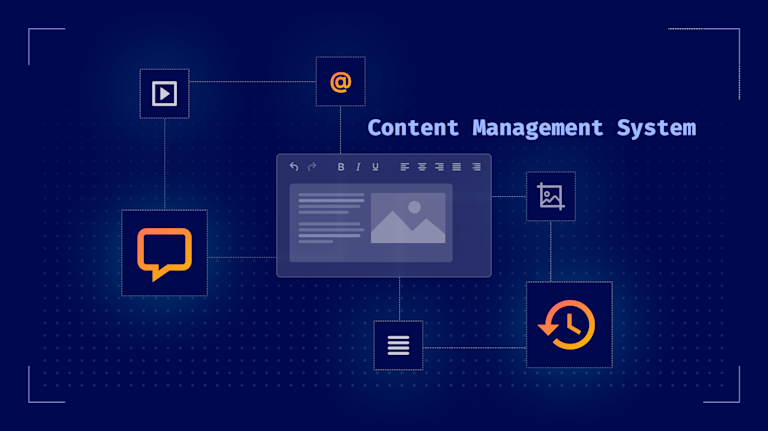The process of content creation has grown from solo tasks to team efforts involving multiple contributors across departments, time zones, and platforms. A workflow that once supported one user in a document must now support half a dozen users in the same place. In the “State of Rich Text Editors 2024: Trends & Insights” report, 56% of respondents said they prefer Google Docs-style co-editing experiences. It’s time to rethink what your web application’s content workflow looks like for your users, especially if you have a rich text editor integrated. Advanced collaborative features are no longer optional in global content workflows. Now, they’re a necessity.
What are collaboration features?
So what are collaboration features in web applications? Collaboration features in rich text editors are tools and functionalities that enable multiple users to work together on a document. It’s common to find these capabilities in apps like document management systems, learning management systems, banking and finance applications, and ecommerce applications. Development teams must anticipate that collaboration features will likely become a future requirement inside their applications, if they’re not already present.
What makes collaboration a must-have feature?
Users of both content management system (CMS) and document management system (DMS) have come to expect collaboration in RTEs as a default feature. From apps like Google Docs to Squarespace and beyond, being able to add colleagues and share work with them is expected functionality across dozens of industries. Apps need features like mentions, comments, and document version history to keep up with product requirements.
Many developers already recognize the need for these collaborative functionalities. In the State of RTE 2024 report, 42% of respondents reported that they value collaboration capabilities as extremely or very important for their RTE. Mentions and comments were specifically ranked as important by 40% of participants, and 48% said that revision history was important. Collaboration features are critical for document management systems, banking and finance applications, learning management systems, and more.
Developers shouldn’t have to build from scratch
These collaboration features shouldn’t have to be built from scratch. Instead of building each feature one at a time in the application, in many cases it’s better to bring in a rich text editor that already has all of them built in.
Why collaboration is hard to build
Collaborative features aren’t easy to engineer. For example, let’s say a development team wants to build a comments feature for their users. Anchoring comments to a specific span of text that might be moved, changed, or deleted takes complex underlying logic. User mentions require user lookups, cursor handling, and inline UI. Even just these features are a lot for any engineer to think about, let alone for a team of engineers to implement.
Using a rich text editor that already has these features makes the development process easier on engineers and product owners alike. Instead of building, testing, and maintaining these complex, intricate systems that allow users to collaborate, the team can integrate and customize a flexible RTE such as TinyMCE to reduce engineering burden and still meet requirements. This way, developers don’t need to orchestrate external plugins or develop solutions from the ground up. Everything works together in one editor: comments, mentions, and revision history.
From functionality to future-proofing RTEs
Let’s look at a few real world examples of how developers can build applications with RTEs that will scale and meet future requirements.
Translation and multi-language support
Asynchronous work is international at this point. Many content creators must develop content for an international market, and often need skilled localization for their projects. Whether it’s adapting content from a cultural perspective or translating it, rich text editors with AI assistant capabilities can help with all of it.
In an advanced RTE like TinyMCE, developers can choose their own AI service from Google Gemini to OpenAI to DeepSeek and more. Then they can engineer custom prompts for user menus that can quickly translate and localize text in seconds. This is just one of the ways developers can future-proof: by customizing a flexible RTE and meeting the needs of international users.

Tracking and accountability
Beyond localization, developers must also prepare for the equally critical demands of compliance and transparency, especially in environments where there are multiple cooks in the kitchen. Revision history is an essential consideration for an application with collaboration.
In content creation workflows, revision history helps reduce human error, maintain version integrity, and safeguard against data loss. With TinyMCE, developers can configure document version control. This supports better collaboration and supports compliance with internal protocols and industry regulations. Future-proofing content means building in guardrails that preserve accuracy and accountability every step of the way.

What’s next? Stay ahead of the curve
As we’ve seen, the demand for collaboration features in rich text editors like comments, mentions, translation tools, and revision tracking, is only growing. Today’s users expect these capabilities out of the box, and tomorrow’s collaborative applications will be defined by how easily they deliver them. Offering advanced collaborative features in your apps isn’t just smart, it’s essential to shaping the future of business.
Developers who invest in feature-rich, flexible RTEs like TinyMCE are setting their products and their users up for success. Don’t wait to catch up. Equip yourself with the insights to build collaborative, future-ready web applications by reading the full State of Rich Text Editors 2024 report, available for download now.
FAQ
What are examples of collaboration features in RTEs?
Collaboration features in rich text editors can include:
- Multi-user editing
- Comments on content
- User mentions within comments
- Content version history showing user changes
Why do developers prefer built-in collaboration tools?
Developers love built-in collaboration tools because they take a huge workload off their plates. Building something like inline comments or user mentions sounds simple…Until you’re knee-deep in edge cases, cursor handling, and content that keeps moving. Instead of reinventing the wheel, teams can reach for a rich text editor like TinyMCE that already has these features baked in. It’s faster, cleaner, and less stressful. All of the collaborative features already work, instead of devs having to put it all together themselves.
How can collaboration features improve compliance?
Collaboration features like revision history do more than just enhance your application for users, they also support compliance. In fast-moving content workflows, being able to track who changed what, and when, keeps everything transparent and auditable. RTEs like TinyMCE let developers build in version control and user-level accountability from the start. That means fewer mistakes, cleaner content records, and a smoother path to meeting internal standards or industry regulations.
